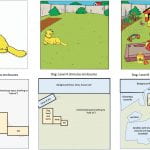Penn State faculty and students will present at ATIA 2023.
Graduate Student Research
Penn State graduate students in Communication Sciences and Disorders, and in Special Education, are involved in a wide variety of AAC research. Recent publications are listed in chronological order below.
ASHA 2022 Presentations by PSU Faculty and Students
Faculty and students presented at ASHA 2022 in New Orleans, LA.
Social Interaction Interventions for Adolescents with Autism: A Meta-Analysis (Babb et al., 2021)
Babb, S., Raulston, T., McNaughton, D., Lee, J., & Weintraub, R. (2021). Social interaction interventions for adolescents with autism: A meta-analysis. Remedial and Special Education, 42(5), 343-357. https://doi.org/10.1177/0741932520956362 Communicating with peers often poses challenges for individuals with autism spectrum disorder (ASD); these social interactions, however, can be especially difficult during the teenage years. For many […]
A Framework to Promote Family-Centered AAC Services (Coburn et al., 2021)
Coburn, K., Jung, S., Ousley, C., Sowers, D., Wendelken, M., & Wilkinson, K. (2021). Centering the family in their system: A framework to promote family-centered AAC services. Augmentative and Alternative Communication, 37(4), 229-240. https://doi.org/10.1080/07434618.2021.1991471 Families are the most significant communication partners for an individual with complex communication needs. Even though family-centered approaches are recommended to support augmentative and alternative communication (AAC) services for […]
The Relation of Visual Attention to Stimulus Complexity and Functional Vision in Individuals With CVI: Implications for AAC (McCarty et al., 2021)
McCarty, T. V., Sowers, D. J., Wolf, S. J., & Wilkinson, K. M. (2021). A preliminary study of the relation of visual attention to stimulus complexity and functional vision in individuals with Cortical Visual Impairment: Implications for augmentative and alternative communication. Perspectives of the ASHA Special Interest Groups, 6(6),1603-1617. https://doi.org/10.1044/2021_PERSP-21-00112 Individuals with cortical visual impairment (CVI) can have […]
- 1
- 2
- 3
- …
- 45
- Next Page »






